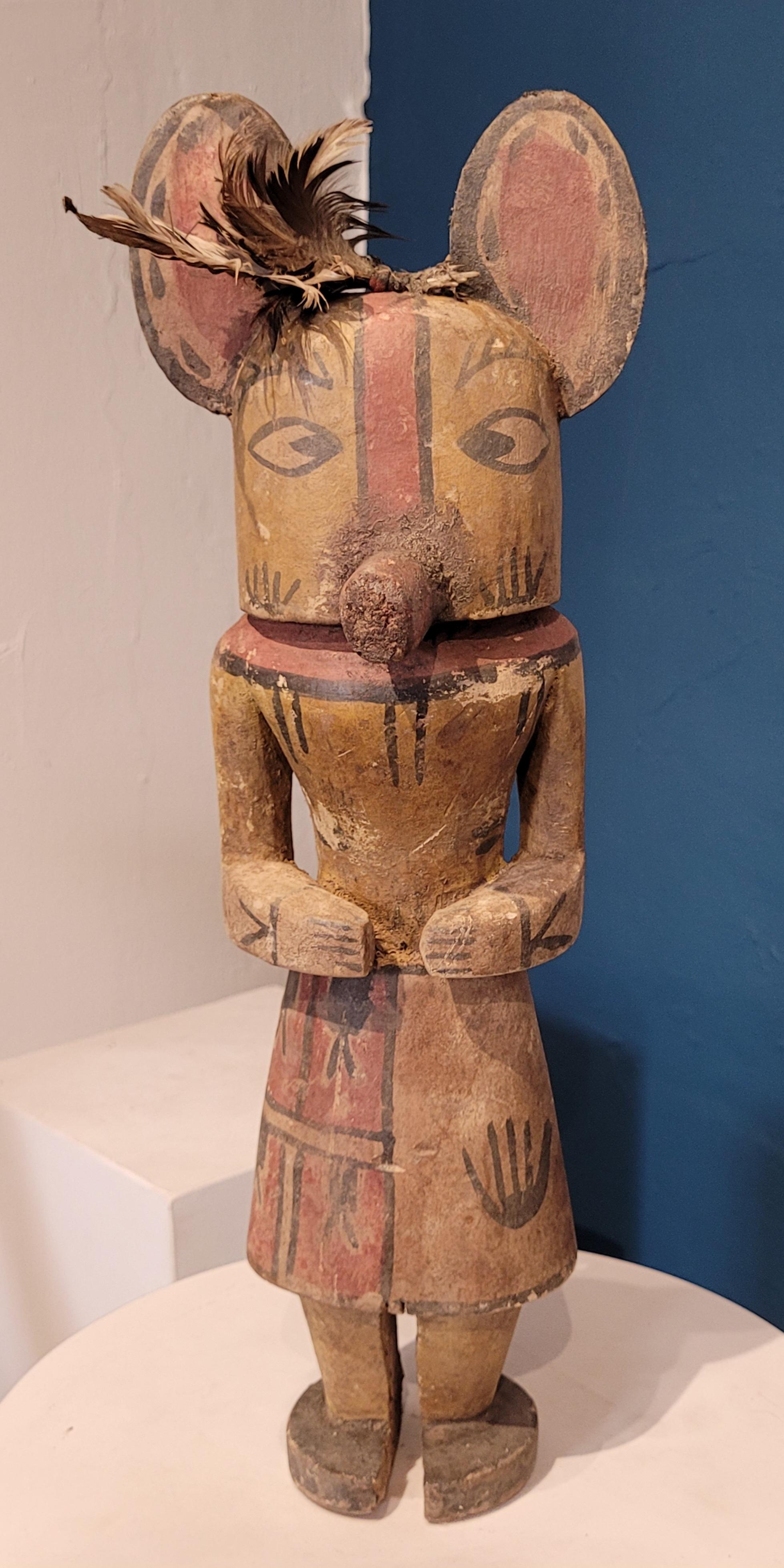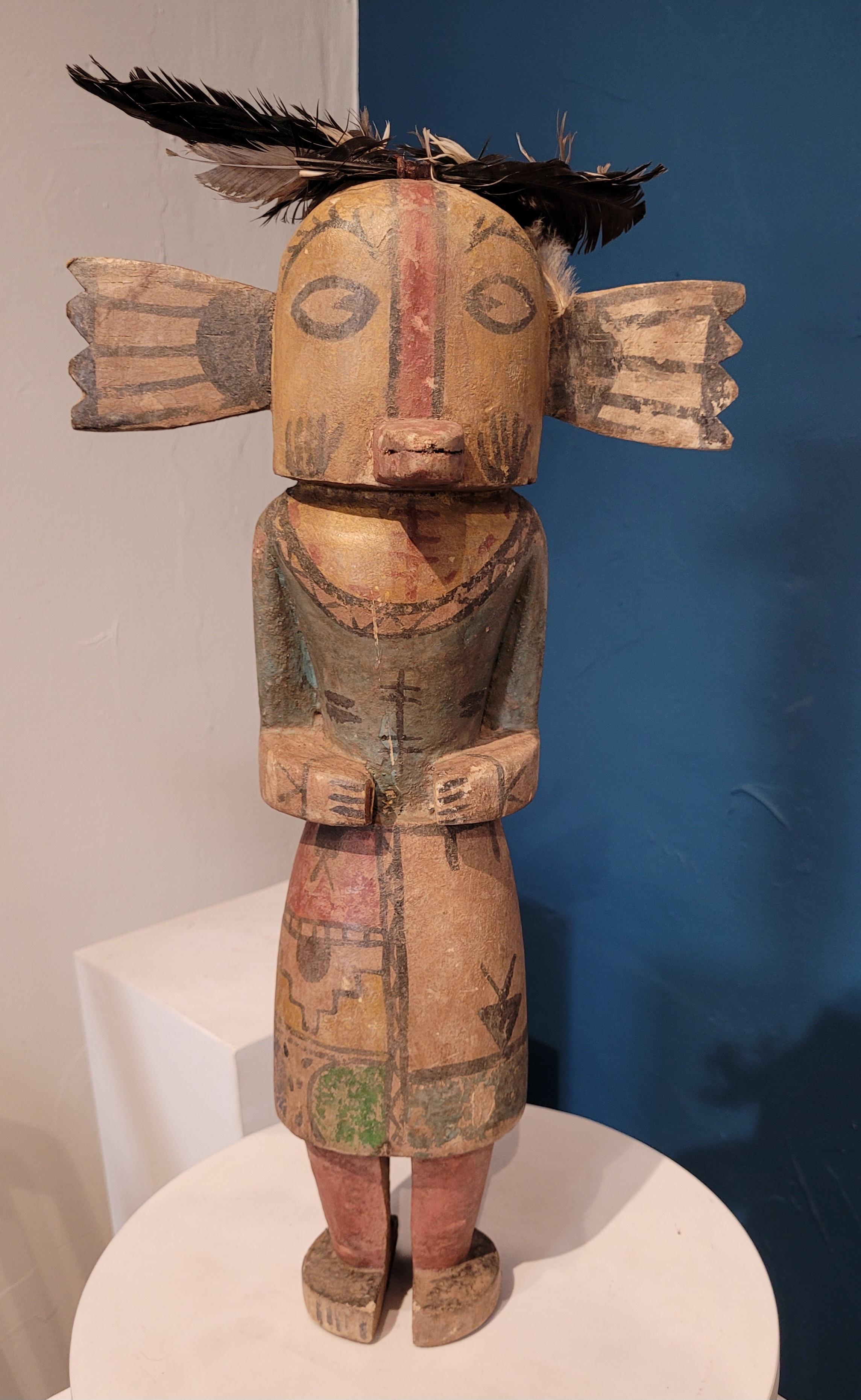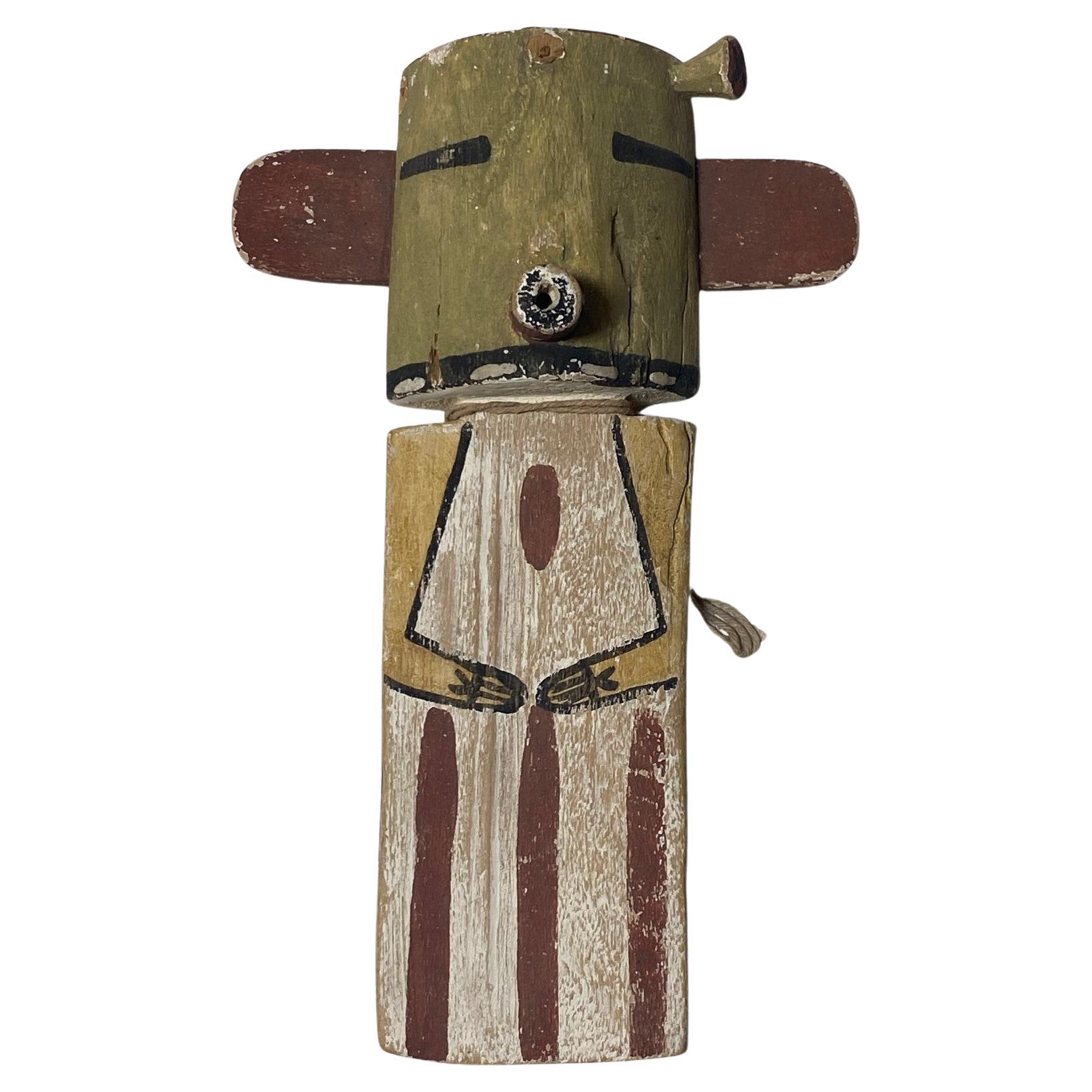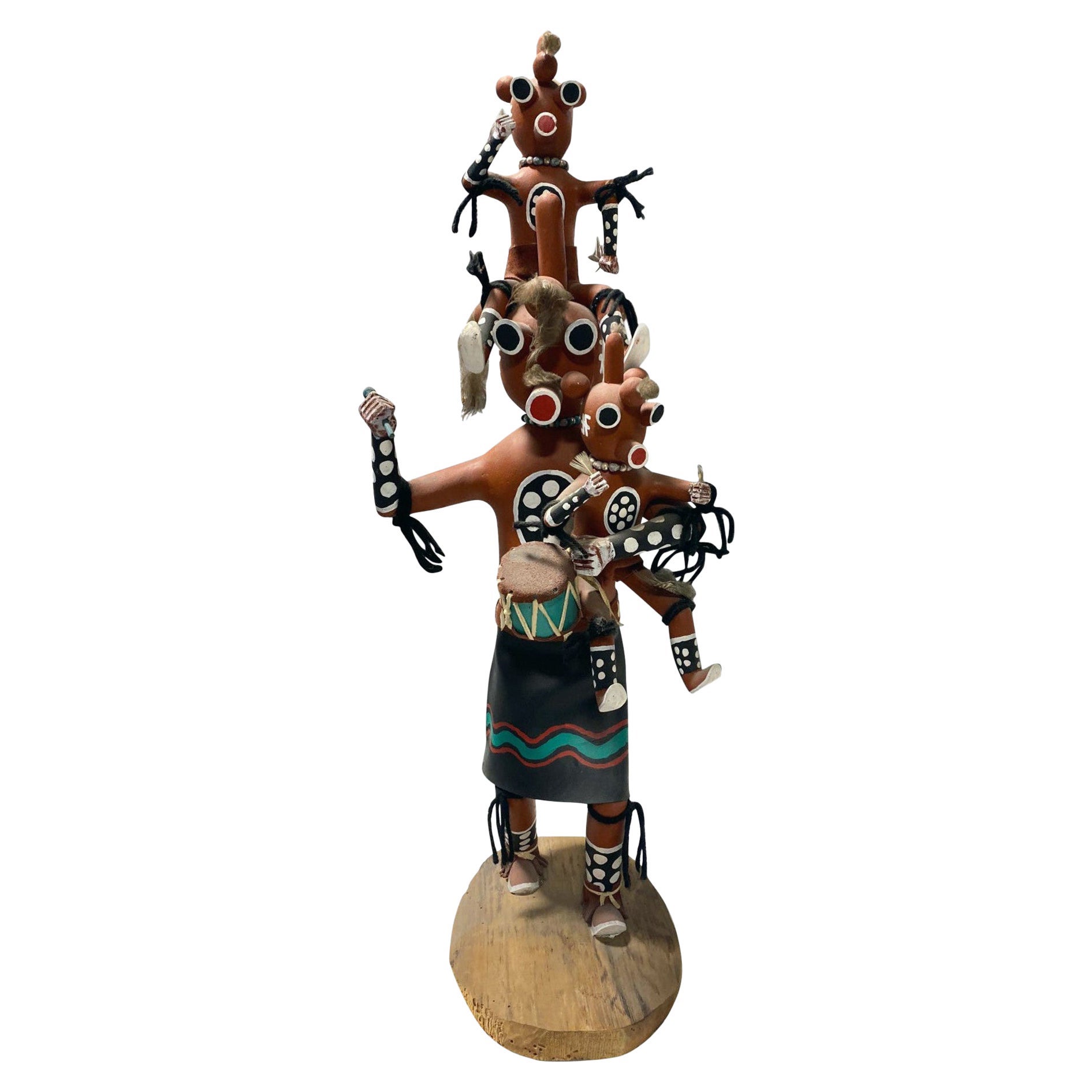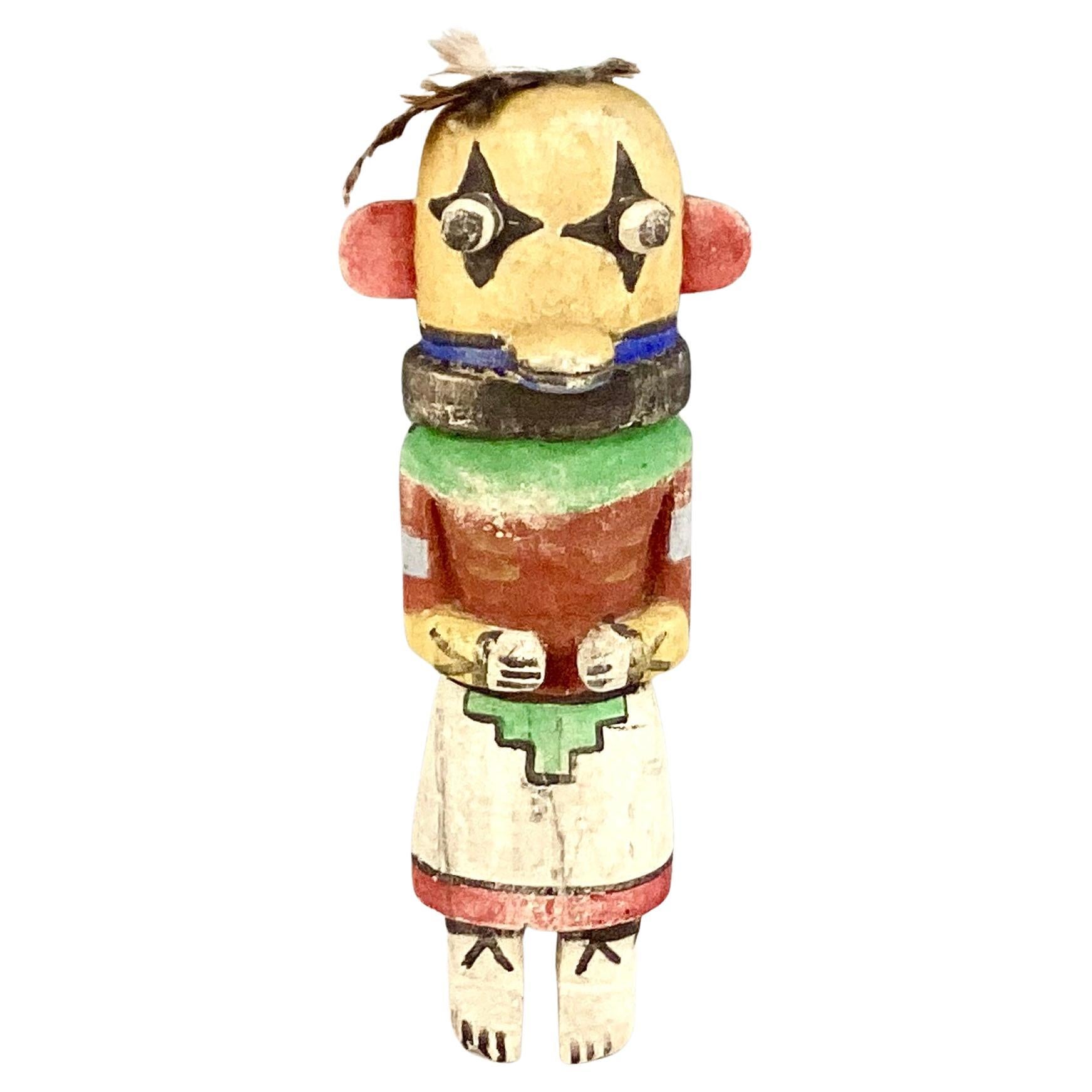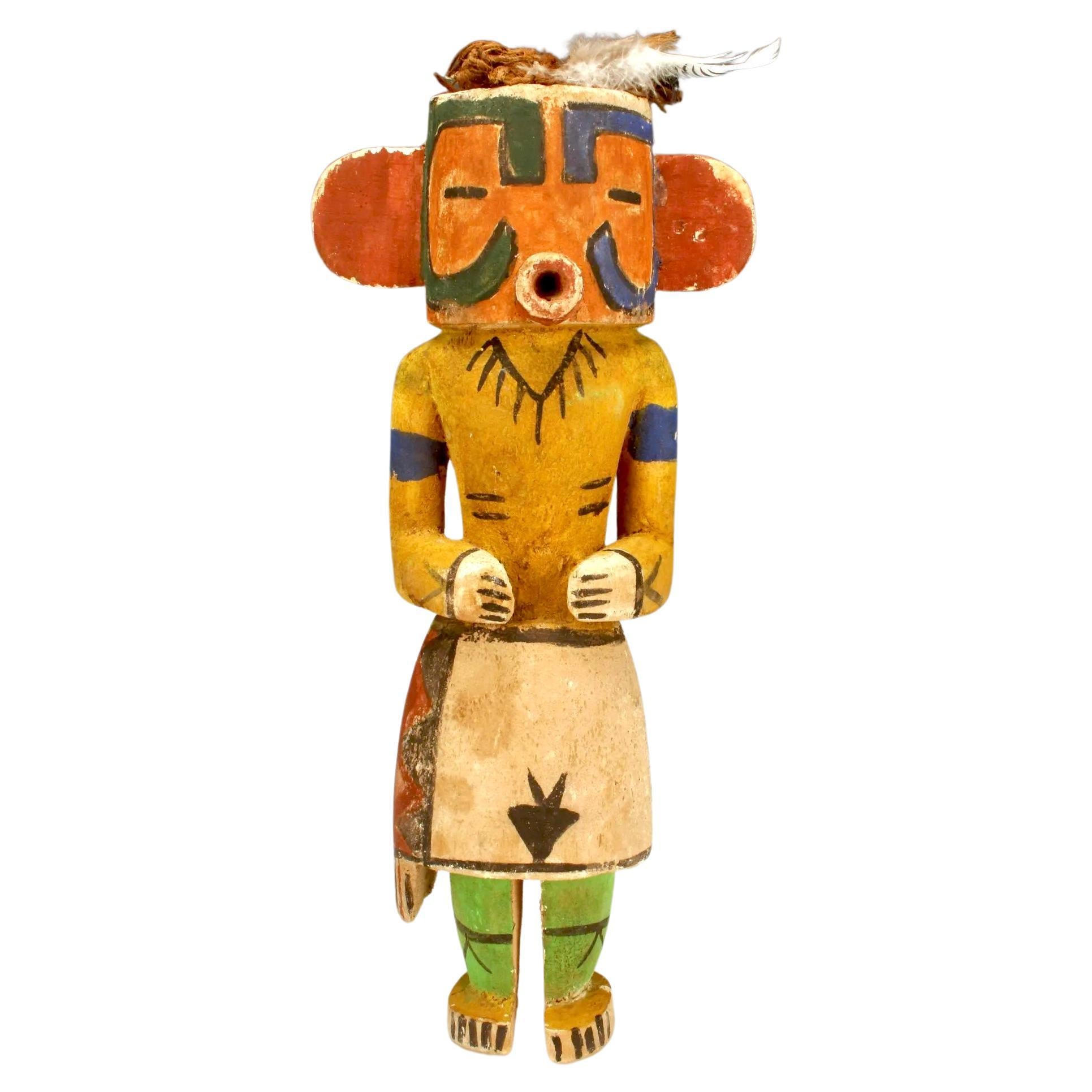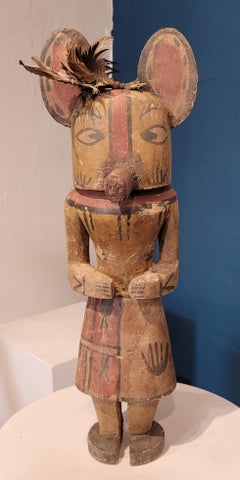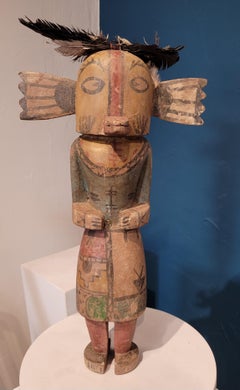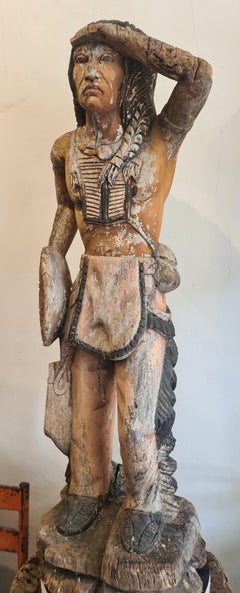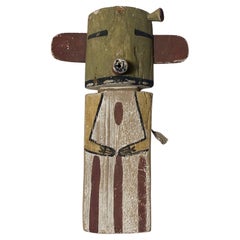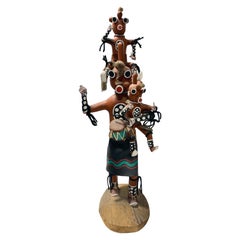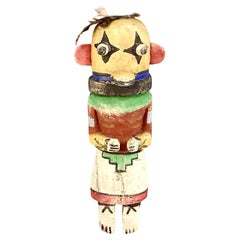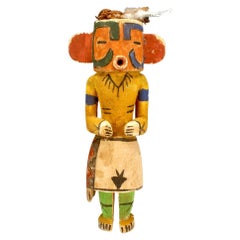Items Similar to Group of Four Native North American Hopi Katsina (Kachina) Dolls in Canoe..
Video Loading
Want more images or videos?
Request additional images or videos from the seller
1 of 12
Hopi CraftsmenGroup of Four Native North American Hopi Katsina (Kachina) Dolls in Canoe..
$3,827.31
£2,849.38
€3,200
CA$5,328.34
A$5,828.40
CHF 3,047.23
MX$70,204.70
NOK 38,086.18
SEK 35,928.96
DKK 24,365.40
About the Item
A group of four Native North American carved wood and painted effigy figures, Hopi Katsina or Kachina dolls paddling their canoe.
Four wonderfully playful, brightly coloured and highly individual Hopi Katsina dolls. Each doll representing a different spirit or element.
Each doll is carved from one piece of cottonwood root and one has separate moving arms.
Hopi Katsina dolls are wooden effigies of the Katsinam (plural), or benevolent spirit beings, who visit the Hopi for about half of every year. Traditionally carved from cottonwood root by Hopi men, they are tangible evidence of the Katsinam's power and wisdom. They are seen amongst other things as rainmakers from the Gods.
According to Hopi tradition, the Katsinam once visited in person, but now come as clouds down from the mountains or up from the earth. They begin arriving in late December, at the winter solstice. Masked and costumed Hopi men assume their powers and prestige in ceremonies and dances held until the Katsinam depart in July. Though only men can be Katsinam, women and children play important roles as their audience; all Hopi men and women belong to the Katsina Society.
The Hopi recognize several hundred katsinam. Many came from Zuni without their original legends and other religious connotations, and have since come to look much more like Hopi Katsinam.
Hopi Katsinam can be male or female, and represent plants, animals, insects, human qualities, the creative force of the sun, and even death. Some are demons who frighten children into behaving properly; most are clan ancestors and beneficent beings. They are messengers who accept Hopi gifts and prayers for health, fertility, and rain and carry them back to the gods. Their role as rainmakers is particularly important to the Hopi, whose agriculture in the high, arid desert of northeastern Arizona has always been precarious.
8Three main ceremonies are performed by and for the Katsinam during their stay in the villages: Soyalangwu, a winter solstice ceremony in December; Powamuyain February, when the katsinam are asked to appear; and Niman, the home-going ceremony, after the summer solstice. Between Powamuya and Niman, they perform several dances that help bring rain, promote the growth of crops, and increase the number of animals the Hopi depend on for survival. Early in the year they are held in underground ceremonial chambers called kivas. As spring arrives, the dances move out onto the plazas, where they last from morning until dusk. At the end of Niman, the katsinam return to the spirit world.
During the dances and ceremonies, Katsina dolls, ortithu (singular:tihu), are given by the Katsinam to infants of both sexes, young girls, and women. Most are given out during Powamuya and Niman. Girls at or near marriageable age receive most of them, although married women sometimes get them from their husbands. A woman who receives a tihu treats it with great respect, hanging it from a beam or wall in her house where it won't come to harm and can continue to benefit her and her family.
Whereas traditionally Hopi Katsina dolls were carved by the Katsinam in the kivas and were used entirely within Hopi culture, since the late 1800s many dolls have been carved as art objects and sold to the general public. Market demand has increased Hopi production of the dolls while adding new technical skills and styles to the Hopi carvers' repertoires.
Katsina dolls are most easily identified by their colors, the types and arrangements of feathers they wear, and the tools, weapons, and other accessories they hold or carry on their backs, all of which are symbols laden with religious meaning.
- Creator:Hopi Craftsmen (Native American)
- Dimensions:Height: 13.39 in (34 cm)Width: 5.52 in (14 cm)Depth: 24.41 in (62 cm)
- Medium:
- Movement & Style:
- Period:
- Condition:
- Gallery Location:Cotignac, FR
- Reference Number:Seller: GB/KatsinaDolls x 4&Canoe.1stDibs: LU1430216548702
About the Seller
5.0
Platinum Seller
Premium sellers with a 4.7+ rating and 24-hour response times
Established in 2000
1stDibs seller since 2020
263 sales on 1stDibs
Typical response time: 2 hours
- ShippingRetrieving quote...Shipping from: Cotignac, France
- Return Policy
Authenticity Guarantee
In the unlikely event there’s an issue with an item’s authenticity, contact us within 1 year for a full refund. DetailsMoney-Back Guarantee
If your item is not as described, is damaged in transit, or does not arrive, contact us within 7 days for a full refund. Details24-Hour Cancellation
You have a 24-hour grace period in which to reconsider your purchase, with no questions asked.Vetted Professional Sellers
Our world-class sellers must adhere to strict standards for service and quality, maintaining the integrity of our listings.Price-Match Guarantee
If you find that a seller listed the same item for a lower price elsewhere, we’ll match it.Trusted Global Delivery
Our best-in-class carrier network provides specialized shipping options worldwide, including custom delivery.More From This Seller
View AllHopi Katsina Doll in Carved Cottonwood.
Located in Cotignac, FR
A Native North American carved wood and painted effigy figure, Hopi Katsina or Kachina doll.
A wonderfully playful, coloured and highly individual Hopi Katsina doll. Each doll repr...
Category
Mid-20th Century Figurative Sculptures
Materials
Wood
Hopi Katsina Doll.
Located in Cotignac, FR
A Native North American carved wood and painted effigy figure, Hopi Katsina or Kachina doll.
A wonderfully playful, coloured and highly individual Hopi Katsina doll. Each doll repr...
Category
Mid-20th Century Figurative Sculptures
Materials
Wood
Cigar Store Indian, Early 20th Century, Carved Wood With Polychrome Decoration
Located in Cotignac, FR
A 20th Century wood carved male figure, a 'Cigar Store Indian' with original polychrome decoration.
A now controversial subject, but none the less charming rendition, of a native North American man originally probably used as an advertising figure. Wonderful quality of carving capturing the stance of the man looking out to the distance, hair flowing to his back and plait to the side, all the details of his costume, his native dress and hairpipe breastplate (suggesting he is possibly a Comanche) and chest ornament, apron, trousers, mocassins, shield and arrows. The original Polychrome decoration has weathered beautifully as has the wood itself to present a sculpture that would adorn any collection or interior.
Because of the general illiteracy of the populace, early store owners used descriptive emblems or figures to advertise their shops' wares. American Indians and tobacco had always been associated because American Indians introduced tobacco to Europeans. As early as the 17th century, European tobacconists used figures of American Indians to advertise their shops.
Because European carvers had never seen a Native American, these early cigar-store "Indians" looked more like Africans with feathered headdresses and other fanciful, exotic features. These carvings were called "Black Boys" or "Virginians" in the trade. Eventually, the European cigar-store figure...
Category
Mid-20th Century American Realist Figurative Sculptures
Materials
Paint, Wood
$2,870 Sale Price
50% Off
African zoomorphic puppet head sculpture from the Bozo Tribe in Mali.
Located in Cotignac, FR
Early 20th century zoomorphic African puppet head sculpture from the Bozo tribe in Mali.
This puppet head would have been used by the Bozo ethnic group during the Sogobo ceremony.
This ancestral tradition continues in the region of Segou in Mali along the Niger river. It is an opportunity to regroup the different villages and give rise to musical and theatrical performances whose highlight is the puppet show...
Category
Mid-20th Century Figurative Sculptures
Materials
Metal
Statue Songye, Republic of Congo, Misangu Glass Beads & Chiefly Raffia Skirt
Located in Cotignac, FR
A Songye Male Power Figure, Democratic Republic of the Congo, the male figure with openwork arms and hands resting on the abdomen, typical facial features and a waterbuck (kobus elli...
Category
Mid-20th Century Tribal Figurative Sculptures
Materials
Metal
$11,481 Sale Price
20% Off
Statue Songye, Kneeling Male Figure, Democratic Republic of Congo
Located in Cotignac, FR
A Songye Male Power Figure, Democratic Republic of the Congo, the male figure resting on one knee, with openwork arms and hands resting by the abdomen which contains various charms a...
Category
Mid-20th Century Figurative Sculptures
Materials
Metal
$3,635 Sale Price
20% Off
You May Also Like
Southwestern Native American Hopi Hand Carved Child Cradle Kachina Katsina Doll
Located in Studio City, CA
A wonderfully hand-painted and decorated Native American Hopi Kachina Katsina doll. We believe this was a child's cradle first Kachina doll. It is hand carved from light wood (likel...
Category
20th Century American Native American Native American Objects
Materials
Wood, Paint
Large Signed Native American Hopi Original Mudhead Kachina Katsina Doll on Stand
By Native American Art
Located in Studio City, CA
A wonderfully handcrafted/detailed and decorated Native American Hopi Mudhead Kachina doll. Quite an unusually large work. A striking piece overall. Hand painted with leather and possibly turquoise (necklace) accompaniment.
Hopi katsina figures, also known as kachina dolls, are figures carved, typically from cottonwood root by the Hopi people. Initially, kachina dolls were made to instruct young girls and new brides about katsinas or katsinam, the immortal beings that bring rain, control other aspects of the natural world and society, and act as messengers between humans and the spirit world. The Mudhead or Koyemsi figure is viewed as a clown/joker figure who is responsible for laughter and entertainment at Hopi dances and ceremonial events. He plays drums and games to keep his audience engaged.
The piece is signed by the artist under the base.
From an extensive collection of Native American objects and artifacts. Would be a great addition to any Native American Art...
Category
20th Century American Native American Native American Objects
Materials
Leather, Wood, Paint
Painted Wood Hopi Katsina Kachina Figure (#2)
Located in Bradenton, FL
Hopi katsina figures (Hopi language: tithu or katsintithu), also known as kachina dolls, are figures carved, typically from cottonwood root, by Hopi people to instruct young girls an...
Category
Mid-20th Century American Native American Native American Objects
Materials
Wood
Painted Wood Hopi Katsina Kachina Figure '#1'
Located in Bradenton, FL
Hopi katsina figures (Hopi language: tithu or katsintithu), also known as kachina dolls, are figures carved, typically from cottonwood root, by Hopi people to instruct young girls an...
Category
Mid-20th Century American Native American Native American Objects
Materials
Wood
Hopi Tasaf Katsina, c. 1940s
Located in Los Angeles, CA
Tasaf Katsina
Hopi
1940s
10 inches H. x 4.50 inches W. x 3.75 inches D.
Cottonwood root, mineral pigments, dyed horsehair, feathers.
Very good original condition overall.
An wonderful example of the Hopi Tasaf Katsina circa early to mid 1940s.
Katsina dolls...
Category
Mid-20th Century American Native American Native American Objects
Materials
Other
Painted Wood Hopi Kachina Figure
Located in Bradenton, FL
Hopi Katsina figures (Hopi language: tithu or katsintithu), also known as Kachina dolls, are figures carved, typically from cottonwood root, by Hopi people to instruct young girls an...
Category
Early 20th Century American Native American Native American Objects
Materials
Wood
More Ways To Browse
Used American Dolls
Wood Carved Figures
Native American Carved Wood
Kachina Native American
Canoe Sculpture
Vintage Wood Canoes
Canoe Paddles Vintage
Tribal Dolls
Hopi Kachina Dolls
Giacometti Kiss
Gillie And Marc Hippo Bronze
Gillie And Marc Hippo
Gillie And Marc Rhino
Giuseppe Armani Disney
Gorilla Buddha
Harriet Lewis
Harris Deller Teapot
Harry Jackson Bronze
